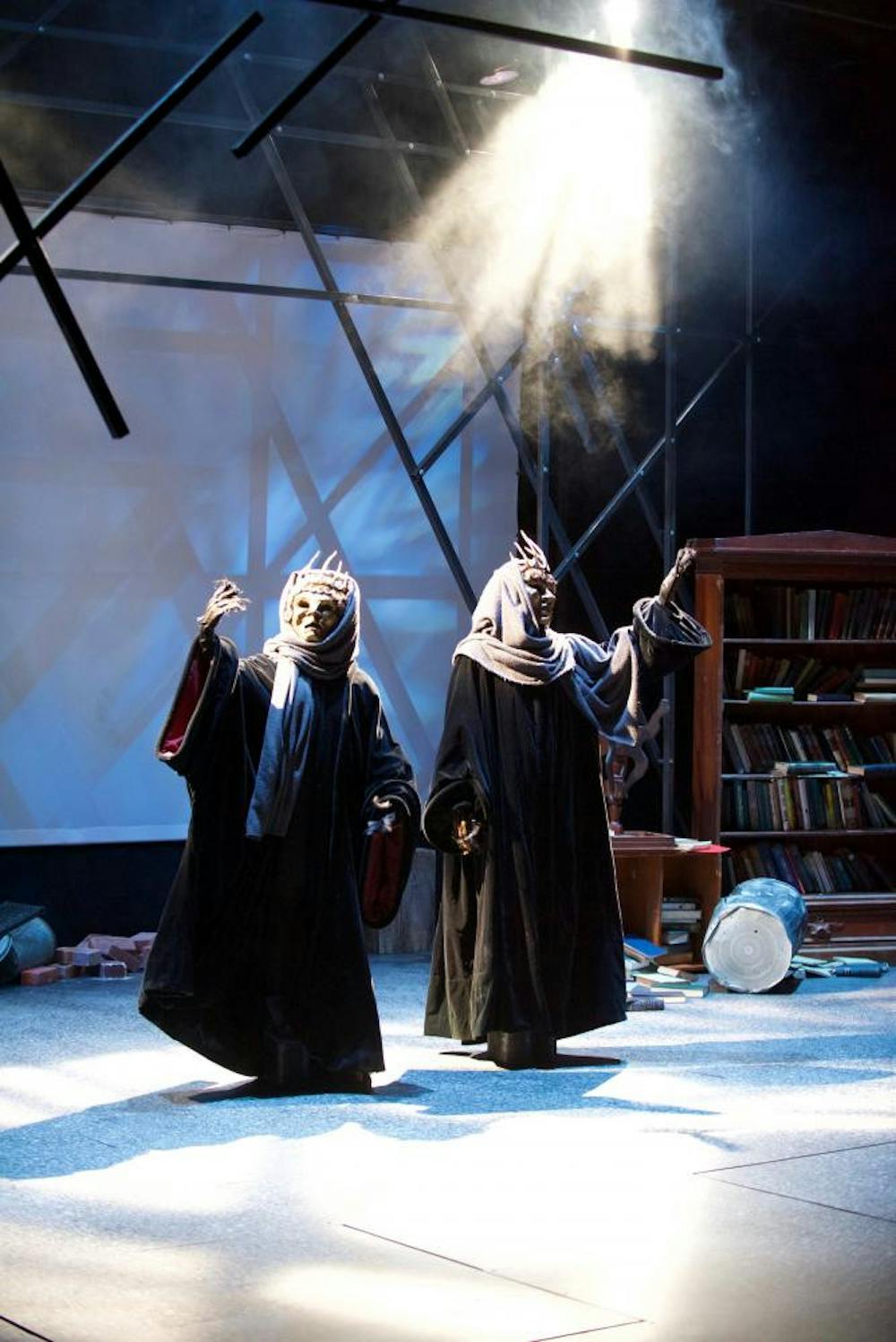When you think of the Greek literary figure Antigone, you probably do not think of surfers, an African village or a postmodern underworld.
From Oct. 27-29, the Middlebury College Theatre and Dance Department’s most recent show, The Antigone Project, challenged the audience’s preconceptions about Sophocles’ well-known Greek tragedy Antigone. The Seeler Studio Theater at the Mahaney Center for the Arts was transformed into a storytelling space, with large monitors on the walls playing both pre-recorded and live footage to compliment the activity on stage. These projections were just some of the many contemporary elements in this re-telling of the ancient story.
Sophocles’ story holds up surprisingly well in its modern renewal. The original story of Antigone follows the young protagonist Antigone, who is determined to bury her brother Polynices after her uncle, the King Creon of Thebes, condemns his corpse to be unburied. After sprinkling dirt on her fallen brother — who fought against Creon in the war — Antigone is condemned for her crime, and she and her lover commit suicide in the end.
It may be a difficult story for audiences to relate to, but these incarnations show that there is more than meets the eye. Each of the five plays in The Antigone Project touches on new themes and elaborates on old themes, modernizing the story of Antigone while staying true to its original subject matter. Each of the one-act plays were written by female playwrights, four of whom are women of color.
“I wanted to do plays by American women,” said Director Richard Romagnoli, a professor of theatre at the College. “These five plays also offered me a great variety of casting and different takes on the condition of women in this country as well as other continents. I thought that was important to capture without necessarily becoming polemical.”
This sentiment was affirmed by Jackson Prince ’17, who took on a plethora of roles in the show.
“We don’t see enough strong women on stage,” said Prince. “The opportunity to tell five different stories in which strong and fiercely motivated women are the focus was a privilege.”
The performance energetically launched into action when the robed two narrators came onstage for a prologue. They were dressed in full Greek drama garb, but soon ditched the masks and tall platform shoes for more comfortable and modern attire. So began the modern rendition of Antigone, but it was only the tip of the iceberg on a wild and emotionally moving journey through time and space.
The first play, “Hang Ten” by Karen Hartman, centers on a Californian, bikini-clad version of Antigone and her flirtatious sister Ismene. They argue about their family’s incestuous history and Antigone’s fixation on her brother’s death until an attractive surfer boy comes ashore and whisks Ismene away.
It is followed by “Medallion” by Tanya Barfield, which is somehow both similar yet distinct from its precursor. Barfield’s interpretation follows Antigone, now played by a black woman, as she desperately tries to attain a Medal of Honor from the United States military so that she can bury her brother who died in battle. The frustration of Antigone as she appeals to the general reflects the frustration of the original Antigone, who was so determined to give Polynices a proper burial.
“Antigone Arkhe” by Caridad Svich harnesses technology to tell the next story. In the play, an archivist gives a slideshow at a museum as Antigone adjacently tells of the thoughts going through her head as she hangs herself in her prison cell.
This was followed by “A Stone’s Throw” by Lynn Nottage, which depicts the plight of a recent widow who is condemned to death by stoning for becoming pregnant while unmarried. This play poignantly highlights the wildly unjust and inhumane treatment of innocent women in countries around the globe, and gives a new life to the story of Antigone.
The performance concludes with “Red Again” by Chiori Miyagawa, in which Antigone and her fiancé find themselves in a Buddhist-inspired underworld after committing suicide. Their condition is juxtaposed with the image of Ismene, who touches upon some of the world’s most significant political disasters such as 9/11 and the bombing of Hiroshima.
The Antigone Project’s depiction of the plight of the modern female – wherever in the world she may be – was not inherently easy to accomplish, according to actress Amanda Whitley ’19.
“As an actor you have to take your character’s side,” said Whitley, who played Antigone in “Antigone Arkhe” and “Red Again.” “Even if you don’t agree with some of their choices or beliefs, you have to own their mindset for the hour and a half that you spend with them. Antigone is not an inherently likable or accessible character for many modern audiences. Her ideals about death and ritual are hard to grasp in a society so far removed from the highly ritualistic world of ancient Greece. So what became a goal and a wonderful take away from The Antigone Project was owning those ideals and making them accessible through various contexts.”
Unlocking this accessibility was one of Romagnoli’s intentions and one of the reasons he picked this show.
“I wanted to give actors who are between 18-21 the opportunity to play characters who are mostly between 18-21,” Romagnoli said. “I thought that with this show there were opportunities for young actors to play characters who were very connected to them.”
This connection contributed to the resonance it had with its audience. The script yielded a diverse and full portrait of a woman from ancient history, while the cast brought each iteration to life.




